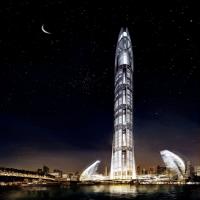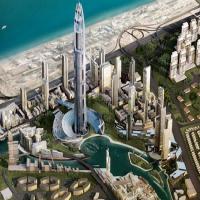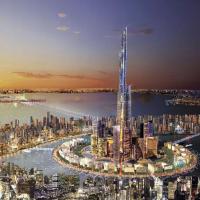Main menu
You are here
Nakheel Harbour and Tower 1,400 m (4,600 ft) - proposed
Nakheel Harbour and Tower



General Information
• Nakheel Harbour and Tower will soar more than 1km high ( 1,400 m (4,600 ft)).
• There would be more than 200 floors and 150 lifts.
• A workforce of approximately 30,000 would be involved in construction.
• There would be a massive 10,000 parking spaces.
• The development would include an additional 40 towers ranging in height from 20 floors to 90 floors (250m-350m).
• There would be over 19,000 residential apartments in the complex.
• 3,500 hotel rooms are planned with a super luxury 100-room hotel to be located at the top of Nakheel tower.
• Nakheel are the master developers of the archipelago of man-made islands – The World.
Nakheel Tower was a proposed skyscraper in Dubai, United Arab Emirates by developer Nakheel. The project was previously called Al Burj .
In January 2009, it was announced that the project was put on hold due to financial problems. As a result of the Dubai World 2009 debt standstill, Nakheel Group's financial problems increased considerably and the tower was consequently cancelled in December 2009.
Nakheel was in talks with several potential contractors which include South Korea's Samsung C&T (who also built Burj Khalifa), Japanese Shimizu Corporation and Australian Grocon. WSP is Lead Consultant for the structure, heading a consortium that includes LERA of New York and VDM of Australia, and working with architects Woods Bagot. The proposed tower would have been 1,400 m (4,600 ft) tall.
Location
The tower was proposed in 2003 as the centrepiece of Palm Jumeirah, one of the world's largest man-made islands. It was to be named "The Pinnacle" and rise from the centre of a canal on the trunk of the island. The height was to be 750 m (2,461 ft) and the building was to consist of 120 floors of luxury apartments. It was replaced by the Trump International Hotel and Tower and moved to the Dubai Waterfront. Although ground leveling and land reclamation had begun on the Dubai Waterfront, construction of the tower never started because of the proximity to the Al Maktoum International Airport, which is currently under construction.
The location was changed to a plot near Jumeirah Lake Towers and Dubai Marina, and soil testing began. The tower would have been the focal point of Nakheel's plans for the Ibn Battuta Mall development next to Jumeirah Islands and Jumeirah Lake Towers. It would have been the center of the Nakheel Harbour and Tower complex, which would have included about 20 smaller towers of up to 90 stories, a marina, and part of the Arabian Canal. The development would have been next to the revamped shopping mall.
Design
The original design conceived by Pei Partnership Architects was to have 631,000 m2 (6,792,000 sq ft) of floor space comprising ultra-luxury apartments, restaurants, a large health club, and an observation deck. The building actually consisted of three separate towers built around a hollow interior and joined together by several sky bridges functioning as sky lobbies. On top of each sky bridge was a sky garden. One of the towers was shorter than the other two with a large outdoor pool on the roof, while the other two were topped with large spires.
A later redesign had the basic shape remain the same - three towers connected by sky bridges with two twin spires and one tower shorter than the others. As for the number of sky bridges, the original design showed only 4, but later renderings showed at first 6, then 9 or 10. The building was also to be mixed-use rather than wholly residential.
With Woods Bagot replacing Pei Partnership as the architectural partner, the latest released design had named the development Nakheel Harbour and Tower. Though in exterior appearance and function it would be a single tower over 1,000 metres (3,300 ft) tall, this even grander incarnation would have been "made up of four towers with four individual cores forming an approximate 100 meters in diameter." Nakheel also claimed on their engineering page that the towers would be joined by four-level, full diameter sky bridges at approximately every twenty-five floors. The sky bridges would act to tie the buildings together structurally as well as to provide each part of the building with its own village centre in the sky. It is the four codependent foundations that would have provided the necessary structural support for such a great relative height increase over existing supertalls. The design included a distinctive crescent-shaped podium encircling the base of the tower.
The tower would have been serviced by 156 lifts at sufficient speeds and capacities to allow for travel from the ground floor to the observation deck in four minutes.
Height
Projections of Nakheel Tower's final height varied widely. Nakheel was believed to be engaging in a strategy of secrecy similar to that employed by Emaar with Burj Khalifa. According to officials at Nakheel, the tower was originally designed to be at least 700 m (2,300 ft) tall and have more than 160 floors although an early render showed the tower with more than 200 floors. Companies involved in the project reported an initial height expectation of 1,600 m (5,200 ft) which was later reduced to 1,200 m (3,900 ft). In July, 2007, Nakheel CEO Chris O'Donnell was reported to have said that "height isn't everything" and suggested that Al Burj might not be any taller than the Burj Khalifa, which is 828 m (2,717 ft). Yet only a week later, Nakheel reaffirmed that the tower would be taller than 1 kilometre. A report on 20 June 2008 claimed that the tower was planned to be 1,400 metres (4,593 ft) tall.
References:

